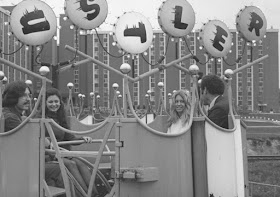by Bryan Whitledge and Casey Gamble
 |
| Marching Chips, Homecoming 2002 |
The 2020 Homecoming at Central is not your usual event. With a public health emergency changing many aspects of our lives, Homecoming is changing, too. This year, Homecoming doesn’t involve a football game or a parade or a pep rally. Instead, the Office of Student Activities and Involvement has created the “Fired Up Challenge” with events like virtual trivia, a virtual concert, and a campus photo challenge. Some traditions will continue though, like the Homecoming Ambassadors. Others are being tweaked to fit our physically distant existence, like the virtual Medallion Hunt and the Special Olympics Homecoming Virtual 5K walk/run that participants can complete on their own.
But, 2020 isn’t the first time that the Homecoming traditions changed. With nearly 100 years of Homecomings at Central, there have been many changes to the tradition over the years.
For example, this isn’t the first Homecoming when football wasn’t the centerpiece event. In 1943, 1944, and 1945, World War II put many campus happenings on hold, among them a Homecoming football game. In 1946, however, Homecoming came back bigger and better than ever at Central with the addition of a new tradition—the Homecoming Queen.
Twenty-five years later, in 1971, it wasn’t a global war that shook up Homecoming traditions—it was the spirit of the times. The Student Alumni Association decided to get rid of the parades, dances, residence hall decorations, and even the Homecoming court. It was reported that students didn’t particularly care about the court and that there were simply not enough parade participants to make that tradition worthwhile. The Student Alumni Association wanted to try something new that all students and alumni could enjoy, so they organized a carnival, a bazaar, and a "style show" instead. The only Homecoming events they held onto from previous years were the pep rally and the football game.
 |
| CMU President Boyd and Students at the Homecoming Carnival, 1971 |
 |
| Homecoming Carnival, 1971 |
As for the parade, the co-chairs declared the bazaar a more than satisfactory replacement. They said that “at least 50 groups requested to build a booth for the bazaar,” which they said meant there was more interest in the bazaar than there was for previous parades. The Homecoming Steering Committee also noted that they did not intend for students to refrain from decorating their residence halls, only that students should decorate lightly and donate to charity the rest of the money that they normally would have spent on decorations. This was another example of the 1971 experiment being more in line with the twenty-first century. The idea of students giving back and supporting a good cause is why the contemporary Homecoming 5K benefiting Special Olympics is such a popular event.
Over the years, Homecoming traditions have faced hurdles, but those hurdles never stopped the events. The cancellation of the football games during WWII didn’t mean and end of Homecoming—in fact, after the War, the tradition expanded. The experiment of the alternative Homecoming of 1971 might not have been popular with everyone at the time, but the spirit of updating Homecoming traditions has lived on—the dances that were popular in 1950s have faded away, while the Medallion Hunt, started in 2003, and the cardboard boat race, started in 1998, have become campus favorites.
 |
| Cardboard Boat Race, ca. 2014 |
In 2024, when Central celebrates the 100th anniversary of the first Homecoming, who knows what new traditions created during the remarkable 2020 Homecoming will live on to be new CMU traditions.
This blog has been adapted from one that appeared in a slightly different form on October 9, 2017.
